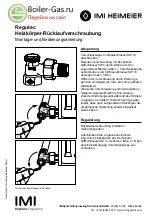
55
Venting the Boiler
2. Combustion requirements are based on the latest edition of
the National Fuel Gas Code, NFPA 54 / ANSI Z223.1; in Canada
refer to the latest edition of CGA Standard CAN/CSA B149.1.
NFB-301C
NFB-399C
Maximum Input
(BTU/H)
301,000
399,000
Outside air from
2 openings directly
from outdoors
A minimum free area of 1 in
2
per
4,000 BTU/H
75 in
2
100 in
2
Outside air from 2
ducts directly from
outdoors
A minimum free area of 1 in
2
per
2,000 BTU/H
150 in
2
200 in
2
Inside air from
2 ducts delivered
from interior space
A minimum free area of 1 in
2
per
1,000 BTU/H
300 in
2
400 in
2
Outside air from
1 openings directly
from outdoors
A minimum free area of 1 in
2
per
3,000 BTU/H
100 in
2
134 in
2
Non-Direct Venting (Single Pipe)
If, at any time, the installation location could experience negative
pressure, there is a possibility of back drafting cold air through the
boiler’s heat exchanger. This situation could lead to the freezing of
the heat exchanger and malfunction of the boiler.
However, building codes in most jurisdictions disallow negative
pressures in residences. In a home with a well-balanced air supply,
the heat exchanger should not be in danger of freezing. Because
the cause of back drafting is not considered a manufacturing
problem, any freezing damage which occurs from back drafting
will not be covered by the Navien warranty. If there is any question
about the possibility of back drafting in the installation location,
use a direct venting system for the boiler.
When using non-direct venting, maintain non-direct vent
clearances shown on page 56 as required by
ANSI Z21.10.3 and
the National Fuel Gas Code, ANSI Z223.1/NFPA 54, and CAN/
CSA B149.1 Natural Gas And Propane Installation Code.
To use non-direct venting for the boiler:
1. Insert the termination end cap into the intake air duct. Do not
glue the end cap, to allow for easy removal and cleaning of the
cap.
Vent Termination Cap 3"
Coupling 3"
Vent Pipe 3"
Ref
Description
Canadian Direct Vent Installations
1
US Direct Vent Installations
2
I
Clearance to service regulator vent outlet
3 ft (91 cm)
*
J
Clearance to nonmechanical air supply inlet to building
or the combustion air inlet to any other appliance
36 in (91 cm)
12 in (30 cm)
K
Clearance to a mechanical air supply inlet
6 ft (1.83 m)
3 ft (91 cm) above if within
10 ft (3 m) horizontally
L
Clearance above paved sidewalk or paved driveway
located on public property
7 ft (2.13 m)
†
*
M
Clearance under veranda, porch deck, or balcony
12 in (30 cm)
‡
*
1 In accordance with the current CSA B149.1 Natural Gas and Propane Installation Code
2 In accordance with the current ANSI Z223.1/NFPA 54 National Fuel Gas Code
† A vent shall not terminate directly above a sidewalk or paved driveway that is located between two single family dwellings and serves both dwellings.
‡ Permitted only if veranda, porch, deck, or balcony is fully open on a minimum of two sides beneath the floor.
* Clearance in accordance with local installation codes and the requirements of the gas supplier.
Summary of Contents for NHB Series
Page 120: ...120 Appendixes 12 6 Component Assembly Diagrams and Part Lists 12 6 1 Case Assembly NFB 301C...
Page 122: ...122 Appendixes 12 6 2 Case Assembly NFB 399C...
Page 124: ...124 Appendixes 12 6 3 Heat Exchanger and Waterway Assembly NFB 301C...
Page 126: ...126 Appendixes 12 6 4 Heat Exchanger and Waterway Assembly NFB 399C...
Page 128: ...128 Appendixes 12 6 5 Combustion Parts Assembly NFB 301C...
Page 131: ...131 Appendixes 12 6 6 Combustion Parts Assembly NFB 399C...
Page 134: ...Memo...
















































